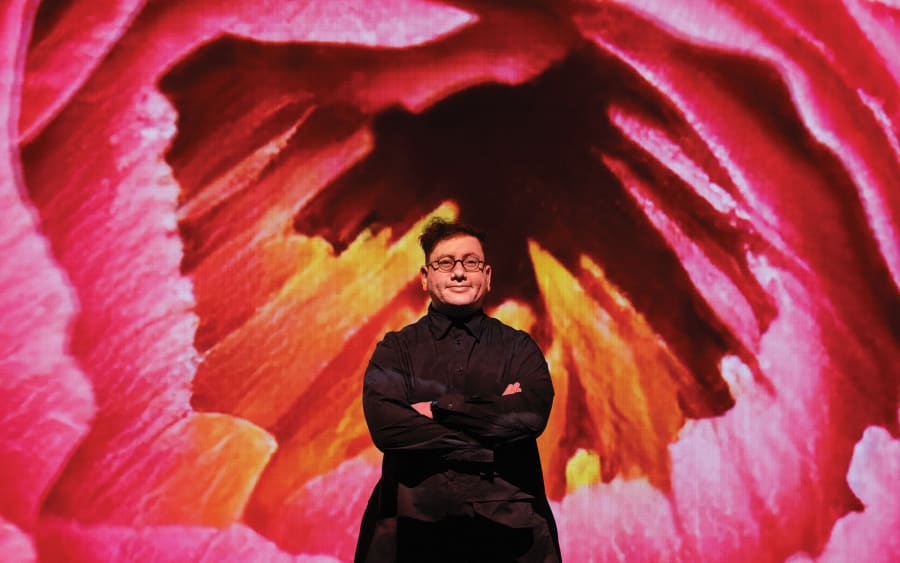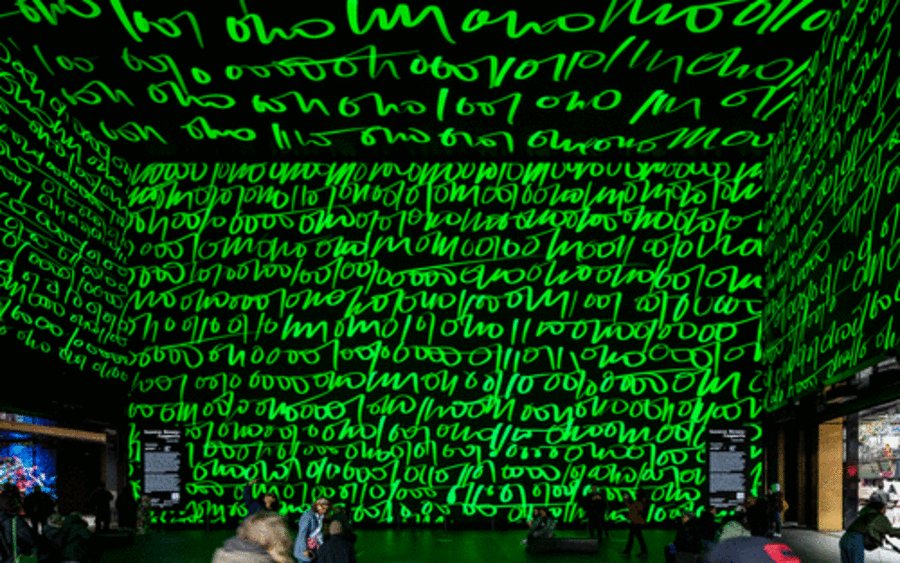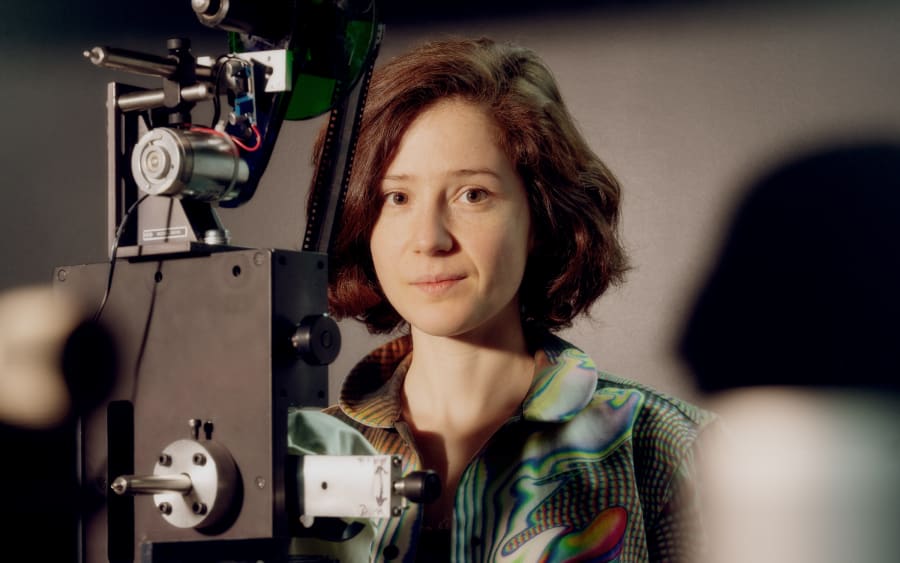The term ‘digital art’ was popularized in the late 1980s and early 1990s with the rise of personal computers and the advent of the World Wide Web, but early pioneers, such as Vera Molnár and Frieder Nake, first began experimenting with digital tools in the 1960s. These artists used mainframe computers to create algorithmic and computer-generated images. In 1967, Fluxus artist Alison Knowles even programmed a Siemens 4004 mainframe to create computer-generated poems (The House of Dust). Today, such legacies are expanded upon by artists such as Refik Anadol, who is known for his immersive installations that use AI and generative processes to visualize data, and Sasha Stiles, who writes poetry in collaboration with an AI alter ego. As technologies evolve, so too does the understanding of digital art.
‘It’s a fascinating exercise to try and define the boundaries of digital art,’ says Hong Kong-based collector Jehan Chu. Chu’s collection primarily consists of artworks in traditional mediums – paintings, works on paper, sculpture – but in 2020, he began taking digital art more seriously and now it comprises a quarter of his collection. ‘For me, digital art is work that both directly utilizes the medium of computers and computation, and that explores the different types of concepts within computation,’ Chu says.
In other words, digital art today does not equate to only NFTs or AI-generated visuals. You also do not need a crypto wallet to acquire it, and it does not necessarily live on a blockchain or your hard drive.
Anadol is perhaps the most well-known artist exploring the different forms digital art can take, both online and in physical spaces. The Turkish American artist often works with artificial intelligence to interpret and transform data into mesmerizing installations that unfold in real time, in real space. For Unsupervised (2022), a massive installation displayed at the Museum of Modern Art in New York, he trained a machine-learning model – an application of AI – to interpret the open-source, or publicly available, data of MoMA’s collection. The model then visualizes its ‘journey’ through the museum’s artworks from the past 200 years. But the installation is also reliant upon the physical space where it is shown: The continuously shifting imagery and sound react to site-specific elements, such as changes in light, movement, acoustics, and the weather outside.
Like many of his works, Anadol sold Unsupervised with a non-fungible token, or NFT; it also came with an artist-signed 3D physical certificate, a custom computer with the work’s software, and a 191 cm display. NFTs are digital certificates of ownership for artworks that can either be stored on or off the blockchain. Many NFTs store only a reference to an artwork, rather than the artwork itself, serving primarily as contracts that define an artwork’s ownership, royalties, and transfer rules. NFTs can be bought, sold, and transferred across different marketplaces, like OpenSea or Blur. The NFT for Unsupervised, for instance, was launched via the marketplace Feral File, and it tracks the artwork’s sales, ensures royalties for the artist, and gives permission to whoever owns the NFT to exhibit the installation (MoMA has acquired the installation). Anadol also sold a series of fine art prints of images generated by the AI model used for Unsupervised; the purchase of such a print is accompanied by an NFT.
An NFT can, however, also be connected with an artwork stored on a blockchain. In simple terms, a blockchain is like a shared digital notebook that keeps a permanent, secure record of information. It comprises a chain of blocks, each of which can be thought of as a page in the notebook, and it is accessible to a large group of people via a network of computers. Each block, or ‘page,’ contains a list of transactions and/or other data, such as image files or texts, which can include links to NFTs. When one block is full, a new block, or another ‘page,’ is added. Once a block is added to the chain, it cannot be changed, ensuring transparency, permanence, and accurate records. So, when an artwork is stored on a blockchain, it is permanently there.
Yet just because an NFT is involved does not mean the work lives only online. Like Anadol and his series of prints, many other artists, including Urs Fischer, Daniel Arsham, and Sarah Meyohas combine NFTs with physical artworks. The first time Jehan Chu acquired a piece of digital art, he actually bought a painting: Christie’s was auctioning Robert Alice’s Block 21 (42.36433° N, -71.26189° E) (2019), from his ‘Portraits of a Mind’ series. From afar, the circular work appears like a target with its bullseye cut out. Upon closer inspection, one notices thousands of letters and numbers, with 32 gold-leaf-encrusted digits hidden among the mass. It is one of 40 such paintings, which together feature the 12.3 million digits of code that first launched Bitcoin technology in 2009 Chu, who had previously worked at Christie’s as a developer and then cofounded the blockchain investment and trading firm Kenetic, advised Alice to attach NFTs to the paintings – and he then bought the painting at auction accompanied by an NFT.
‘To some extent, my introduction to digital art was being involved in it, which bound me to it even more closely,’ Chu says. But, he continues, for those with no connection to digital spaces, learning about, engaging with, and acquiring digital art has become ‘as easy as looking at social media or logging into Gmail.’
To acquire digital artworks, including those attached to an NFT or on a blockchain, does not necessarily require cryptocurrency. The platform Nifty Gateway sells NFTs priced in USD that are available to purchase via credit card or bank transfer, while third party payment systems such as MoonPay, which converts fiat money to cryptocurrencies, make it easy to purchase work on platforms that require crypto. When it comes to blockchain-based work, a collector does usually need a crypto wallet, but it can be funded via credit card or bank transfer, and a blockchain like Tezos makes the set-up process user-friendly and easy to navigate. Galleries such as Nagel Draxler and bitforms have also sold artworks attached to NFTs; such a purchase can be made in the same way as acquiring a painting.
When it comes to identifying valuable pieces of digital art, Chu has two pieces of advice for collectors new to the space: ‘Start where you’re comfortable, meaning institutionally validated, and then leave behind any baggage and come to “digital art” with a fresh mind.’ He suggests ‘following the “traditional” institutions and curators who are already in the digital realm and who can provide a warm intro into the space.’ He points to MoMA and Los Angeles County Museum of Art as two institutions with impressive digital art programming that is accessible to newcomers, and to curators like Hans Ulrich Obrist, Glenn Phillips, Adam Levine, and Christiane Paul as helpful guides.
Beyond institutions, collectors can also look to international galleries including Nagel Draxler and bitforms as well as Pace, with its Pace Verso initiative, and Ora-Ora, whose programs help make this field accessible, both in terms of understanding seemingly complex concepts as well as methods of acquisition. For example, a 2023 exhibition titled ‘Code Chronicles’ at bitforms focused specifically on generative art. The accompanying text explained that ‘generative art dates to the mid-20th century, while AI has emerged by leveraging advancements in machine learning.’ Generative art often relies on mathematical algorithms and rule-based systems, offering artists more control over the outcome and a predetermined aesthetic. AI, on the other hand, learns patterns in a dataset to render imagery. The dataset can be crafted by the artist, but the aesthetic is less predictable than that resulting from generative processes.
At Ora-Ora in Hong Kong, the 2024 exhibition ‘Generative Canvas’ exemplified how an artist working with generative processes can create purely physical results to be acquired in traditional methods. The show featured a suite of paintings by Peng Jian, who used software to repeatedly regenerate selected photographs, which then served as the reference points for his final works on canvas.
While digital art is a term with an ever-expanding meaning, encompassing technologies of the past, present, and near future, it likewise has an ever-expanding presence in the art world. ‘Digital art really is the art of this generation,’ Chu says. ‘Given how digitally native our lives already are, and how digitization acts as a surface for us to face the real world – whether through our phones, through television, through information that’s been digitized and then re-analogued – so much of our existence depends on this digital interface, and who better to help us understand the digital world than artists?’
Emily McDermott is a writer and editor living in Berlin.
Top image: Alison Knowles, The House of Dust Edition, 1967, presented by James Fuentes at Art Basel 2021.
Published on February 6, 2025.


